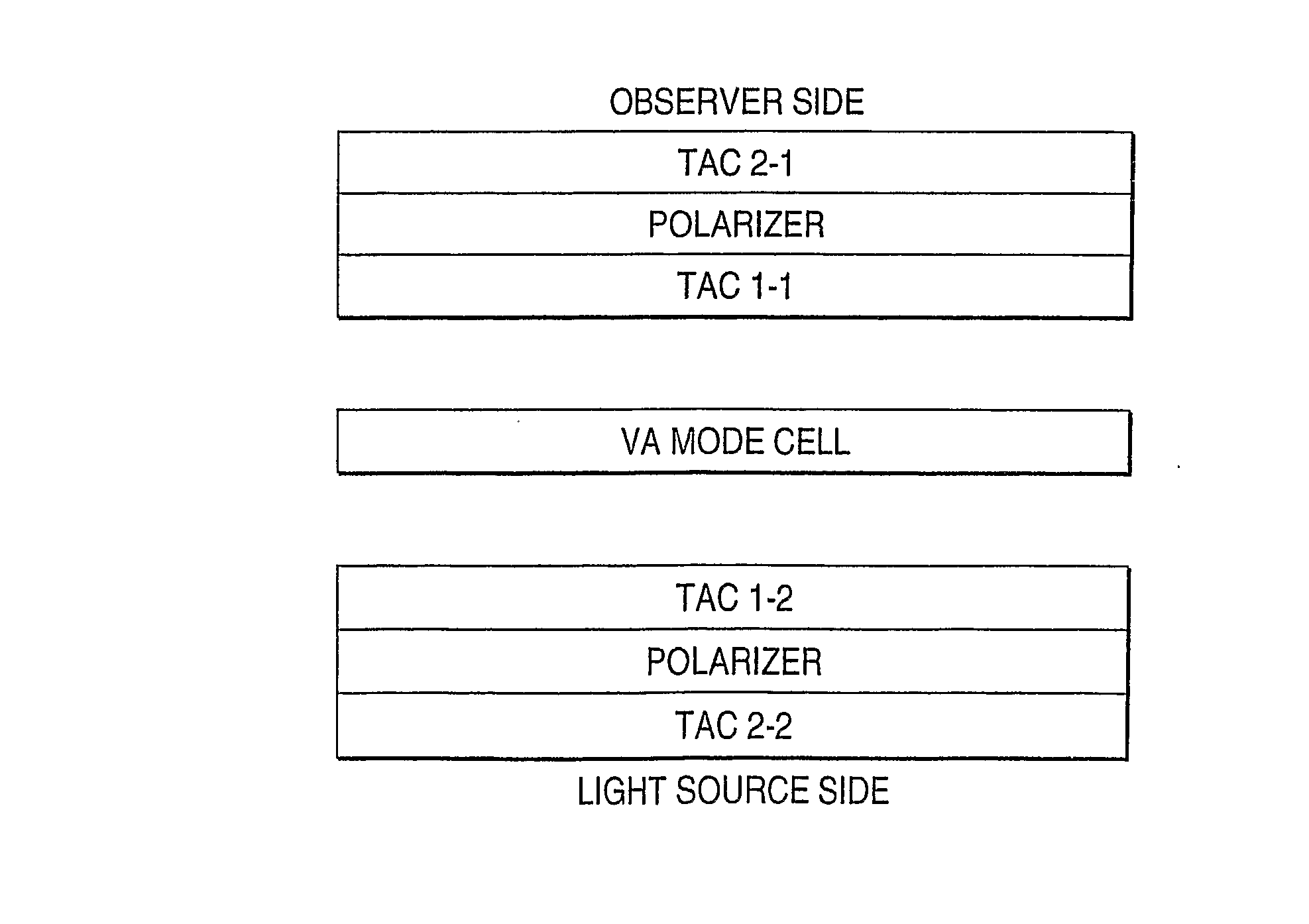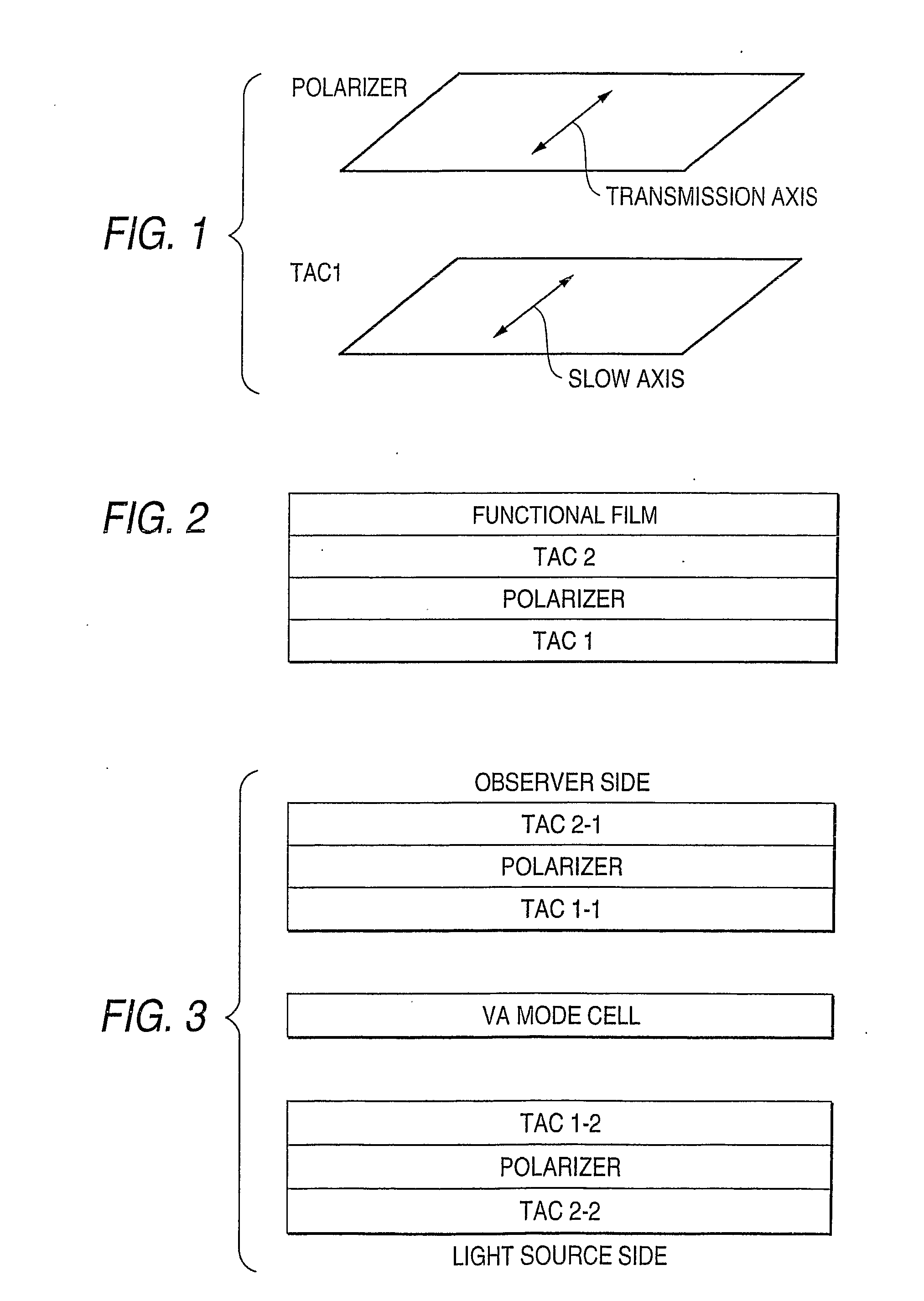Optical Cellulose Acylate Film, Polarizing Plate and Liquid Crystal Display
- Summary
- Abstract
- Description
- Claims
- Application Information
AI Technical Summary
Benefits of technology
Problems solved by technology
Method used
Image
Examples
example 1
1. Formation of Cellulose Acylate Films
(1) Cellulose Acylates
[0213] Cellulose acylates described in Table 1, which are different in the degree of acetyl substitution, were prepared. Acylation reaction was conducted at 40° C. by adding sulfuric acid (7.8 parts by weight based on 100 parts by weight of cellulose) as a catalyst, and adding a carboxylic acid. Then, the amount of the sulfuric acid catalyst, the amount of water and the ageing time were adjusted to adjust the total degree of substitution and the degree of substitution at the 6-position. The ageing temperature was 40° C. Further, low molecular weight components of this cellulose acylate were removed by washing with acetone.
(2) Preparation of Chlorine-Based Organic Solvent Dopes
[0214] Each of the cellulose acylates described in Table 1 and a plasticizer (a 2:1 mixture of triphenyl phosphate and biphenyldihenyl phosphate) were put into a mixed solvent of dichloromethane / methanol (87 / 13 parts by weight) with stirring to ...
example 2
(Preparation of Polarizing Plates-1)
[0218] Iodine was allowed to be adsorbed by a stretched polyvinyl alcohol film to prepare a polarizer.
[0219] Each of the cellulose acylate films prepared in Example 1 (F1 to F8: corresponding to TAC 1 of FIGS. 1 and 2 or TAC 1-1 or 1-2 of FIG. 3) was subjected to saponification treatment, and was bonded to one side of the polarizer with a polyvinyl alcohol-based adhesive. Saponification treatment was performed under the following conditions.
[0220] A 1.5 N sodium hydroxide aqueous solution was prepared and kept warm at 55° C. A 0.01 N diluted sulfuric acid aqueous solution was prepared and kept warm at 35° C. The cellulose acylate film prepared was immersed in the above-mentioned sodium hydroxide aqueous solution for 2 minutes, and then, immersed in water to thoroughly wash away the sodium hydroxide aqueous solution. Then, the film was immersed in the above-mentioned diluted sulfuric acid aqueous solution for 1 minute, and then, immersed in wat...
example 3
Mounting to VA Panel
One Sheet Type
[0252] A liquid crystal display of FIG. 3 was prepared. That is to say, an upper polarizing plate (TAC 2-1 (having a functional film / no functional film), a polarizer and TAC 1-1), a VA mode liquid crystal cell and a lower polarizing plate (TAC 1-2, a polarizer and TAC2-2) were laminated from the observer side (upper side), and a back light source was arranged. In the following example, a commercially available polarizing plate (HLC2-5618) was used as the upper polarizing plate, and a polarizing plate formed integrally with an optical compensating film was used as the lower polarizing plate. However, even when this arrangement is reversed, there is no problem functionally. The integral type polarizing plate is preferably used as the lower polarizing plate (because when it is used as the upper polarizing plate, it is necessary to provide the functional film on the observer side (upper side), which may cause a decrease in production yield ratio), and...
PUM
| Property | Measurement | Unit |
|---|---|---|
| Temperature | aaaaa | aaaaa |
| Temperature | aaaaa | aaaaa |
| Time | aaaaa | aaaaa |
Abstract
Description
Claims
Application Information
 Login to View More
Login to View More - R&D
- Intellectual Property
- Life Sciences
- Materials
- Tech Scout
- Unparalleled Data Quality
- Higher Quality Content
- 60% Fewer Hallucinations
Browse by: Latest US Patents, China's latest patents, Technical Efficacy Thesaurus, Application Domain, Technology Topic, Popular Technical Reports.
© 2025 PatSnap. All rights reserved.Legal|Privacy policy|Modern Slavery Act Transparency Statement|Sitemap|About US| Contact US: help@patsnap.com



